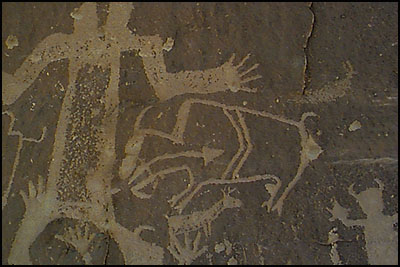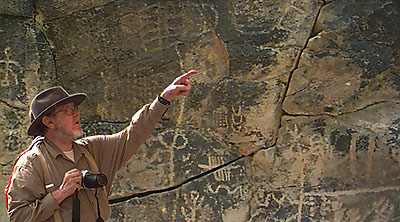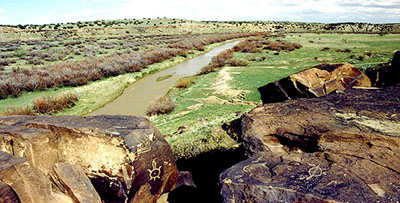
|
The Mystery of Ancient America's
ViewZone will attempt to give you all the details.
 Some of the petroglyphs in Southeast Colorado were different from anything we had seen in either Arizona or in Martineau's book. Only a few of the stick figures, with circles as heads, seemed familiar. It was writing but in what form? There were what appeared to be organized groups of symbols, about twenty six different ones in all, that were repeated on hundreds of rocks along the canyons of the Pergatory River. Most of the "writing" was within a narrow region of land that stretches from the Arkansas River to the Oklahoma panhandle, near the Cimmeron River.

Bill McGlone has spent a good part of his life photographing petroglyphs Viewzone was hosted by Bill McGlone, a highly intelligent man who has been the hub of what little research has been done in this area. Bill moved to La Junta, Colorado soon after he retired. Being an engineer, his mind was always active and curious about his surroundings. All his life, Bill had been learning the local history and visiting the locations of decisive battles and event-- in whatever region of the world his occupation took him. Originally from Indiana, Bill was drawn to this beautiful and friendly town by something he had seen while visiting the area - a very real mystery - and one that he would pursue for the rest of his lefe. Before we really let you have the details we must warn you. First, don't put down your copy of The Rocks Begin To Speak, because you will see lots of Plains Indian style petroglyphs and pictographs. The Native Americans used many of the same walls to petition the Great Spirit or to record their own events and ideas. These petroglyphs often are carved over a darkly patinated and much older collection of repeating letters. We also ask you to keep an open mind about what you see. There is very little known about this phenomenon and, in a very real sense, you are part of our expedition. You share in the mystery and the solution to this historic riddle.
The Sites
The archaeological region we visited is deceptively blank (white space) on most maps of Colorado. In fact there are little signs of civilization in this dusty area. It's the "wide open space" where the buffalo once roamed. The area is a patchwork of barbed wire fences and cattle troughs. The deep canyons in this ptherwise flat landscape seem to have been etched from the sandstone by what remains of the Pergatory River (or "Picket Wire" as it is called by locals). Just a few hundred years ago, this area was quite different. The grass was taller and ungrazed. Its 4 to 5 foot height rippled like water as the winds pushed across the rugged landscape. Historians call it the "Sea of Grass" because, like a sea, it was difficult to cross and remained isolated from the surrounding communities. Only when the Native Americans utilized the Spanish horses, in the 16th Century, did travel and hunting become worth the effort. But much earlier and deep inside the Sea of Grass there were people that could read and write.
 Could the "Picket Wire" or Pergatory River Canyons have been the community of an ancient sea-faring culture?
|
